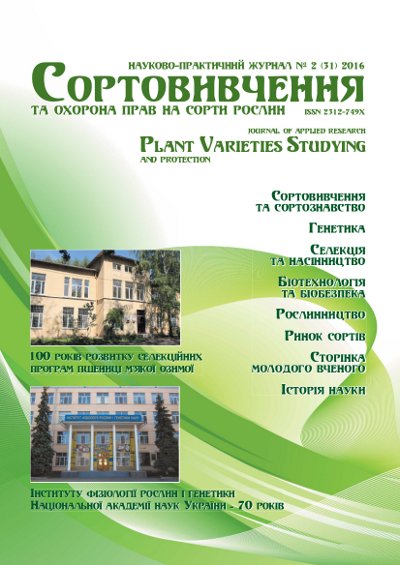Criteria of high-oleic sunflower oil evaluation
DOI:
https://doi.org/10.21498/2518-1017.2(31).2016.70266Keywords:
high oleic sunflower oil, gas chromatography, oil quality indicatorsAbstract
Purpose. To perform the gas chromatography test of sunflower oil samples varied in the oleic acid content. To demonstrate the possibility of the oil samples discrimination by the use of relatively simple express-procedures for oleic acid content determination to be applied in sunflower breeding area as well as in routine original or counterfeit oil quality evaluation. Methods. International ISO standards and statistical evaluation. Results. The simplified gas chromatography procedure has been applied for sunflower oil fatty acid composition evaluation. Dependence of a number of physical methods such as oil light refraction, cinematic oil viscosity and oil density tests on oil fatty acid composition especially oleic acid content was determined. Conclusions. The GC test was the most informative and effective in terms of correct oleic acid content determination at all stages of breeding process and in commercial production as well. Physical procedures based on oil light refraction, cinematic oil viscosity and oil density tests are worthy of attention as the tight correlation between these indicators and oleic acid content in sunflower oil was defined.
Downloads
References
Soldatov, K. I. (1976). Chemical mutagenesis in sunflower breeding. In Proc. 7th Int. Sunflower Conf., Krasnodar, June 27 – July 3, 1976. (рр. 352–357). Krasnodar, USSR.
Urie, A. L. (1985). Inheritance of high oleic acid in sunflower. Crop Science, 25(6), 986–989.
Miller, J. F., & Zimmerman, D. C. (1983). Inheritance of high oleic fatty acid content in sunflower. Proc. Sunflower Research Workshop. (p. 10). Fargo, ND.
Monotti, M. (2004). Growing non-food sunflower in dry land conditions. Ital. J. Agron., 8(1), 3–8.
Derzhavnyi reiestr sortiv roslyn, prydatnykh dlia poshyrennia v Ukraini na 2015 rik [State register of plant varieties suitable for dissemination in Ukraine in 2015]. Retrieved from: http://vet.gov.ua/sites/default/files/ReestrEU-2015-01-14a.pdf. [in Ukrainian]
Arutyunyan, N. S., Korneva, E. P., Martovshchuk, E. V., Mosyan, A. K., & Arisheva, E. A. (2004). Laboratornyy praktikum po khimii zhirov [Laboratory practicum on the chemistry of fats]. N. S. Arutyunyan, & E. P. Korneva (Eds.). (2nd ed., rev.). St. Petersburg: GIORD. [in Russian]
Dzhi M. (2001). Sovremennye sredstva analiza zhirov i masel [Advanced tools for analysis of fats and oils]. Maslozhirovaya promyshlennost [Fat and Oils Processing Industry], 1, 19–20. [in Russian]
Downloads
Published
How to Cite
Issue
Section
License
Copyright (c) 2016 Ukrainian Institute for Plant Variety Examination

This work is licensed under a Creative Commons Attribution-ShareAlike 4.0 International License.
Starting in 2022, the copyright to the publication remains with the authors
Our journal abides by the CREATIVE COMMONS copyright rights and permissions for open access journals.
Authors, who are published in this journal, agree to the following conditions:
- The authors reserve the right to authorship of the work and pass the first publication right of this work to the journal under the terms of a Creative Commons Attribution License, which allows others to freely distribute the published research with the obligatory reference to the authors of the original work and the first publication of the work in this journal.
- The authors have the right to conclude separate supplement agreements that relate to non-exclusive work distribution in the form in which it has been published by the journal (for example, to upload the work to the online storage of the journal or publish it as part of a monograph), provided that the reference to the first publication of the work in this journal is included.

























 Ukrainian Institute for Plant Varieties Examination
Ukrainian Institute for Plant Varieties Examination  Селекційно-генетичний інститут
Селекційно-генетичний інститут Institute of Plant Physiology and Genetics of the National Academy of Sciences of Ukraine
Institute of Plant Physiology and Genetics of the National Academy of Sciences of Ukraine
 The National Academy of Agrarian Sciences of Ukraine
The National Academy of Agrarian Sciences of Ukraine